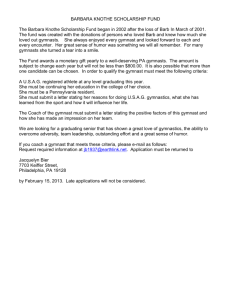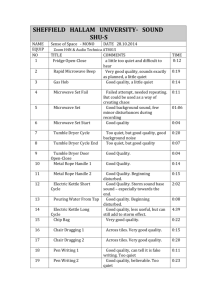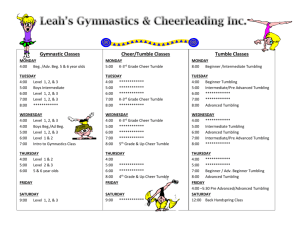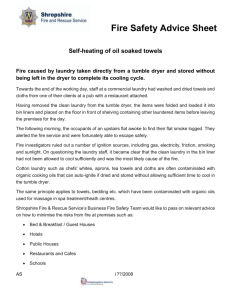INDIVIDUAL VOLUNTARY FLOOR RULES
advertisement
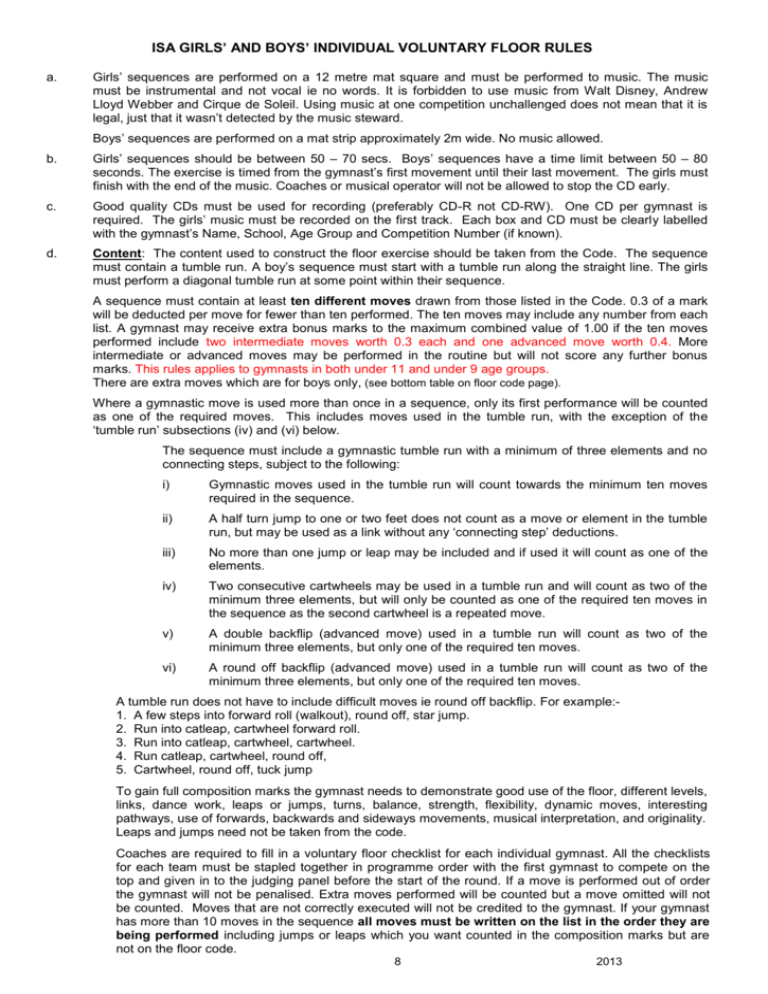
ISA GIRLS’ AND BOYS’ INDIVIDUAL VOLUNTARY FLOOR RULES a. Girls’ sequences are performed on a 12 metre mat square and must be performed to music. The music must be instrumental and not vocal ie no words. It is forbidden to use music from Walt Disney, Andrew Lloyd Webber and Cirque de Soleil. Using music at one competition unchallenged does not mean that it is legal, just that it wasn’t detected by the music steward. Boys’ sequences are performed on a mat strip approximately 2m wide. No music allowed. b. Girls’ sequences should be between 50 – 70 secs. Boys’ sequences have a time limit between 50 – 80 seconds. The exercise is timed from the gymnast’s first movement until their last movement. The girls must finish with the end of the music. Coaches or musical operator will not be allowed to stop the CD early. c. Good quality CDs must be used for recording (preferably CD-R not CD-RW). One CD per gymnast is required. The girls’ music must be recorded on the first track. Each box and CD must be clearly labelled with the gymnast’s Name, School, Age Group and Competition Number (if known). d. Content: The content used to construct the floor exercise should be taken from the Code. The sequence must contain a tumble run. A boy’s sequence must start with a tumble run along the straight line. The girls must perform a diagonal tumble run at some point within their sequence. A sequence must contain at least ten different moves drawn from those listed in the Code. 0.3 of a mark will be deducted per move for fewer than ten performed. The ten moves may include any number from each list. A gymnast may receive extra bonus marks to the maximum combined value of 1.00 if the ten moves performed include two intermediate moves worth 0.3 each and one advanced move worth 0.4. More intermediate or advanced moves may be performed in the routine but will not score any further bonus marks. This rules applies to gymnasts in both under 11 and under 9 age groups. There are extra moves which are for boys only, (see bottom table on floor code page). Where a gymnastic move is used more than once in a sequence, only its first performance will be counted as one of the required moves. This includes moves used in the tumble run, with the exception of the ‘tumble run’ subsections (iv) and (vi) below. The sequence must include a gymnastic tumble run with a minimum of three elements and no connecting steps, subject to the following: i) Gymnastic moves used in the tumble run will count towards the minimum ten moves required in the sequence. ii) A half turn jump to one or two feet does not count as a move or element in the tumble run, but may be used as a link without any ‘connecting step’ deductions. iii) No more than one jump or leap may be included and if used it will count as one of the elements. iv) Two consecutive cartwheels may be used in a tumble run and will count as two of the minimum three elements, but will only be counted as one of the required ten moves in the sequence as the second cartwheel is a repeated move. v) A double backflip (advanced move) used in a tumble run will count as two of the minimum three elements, but only one of the required ten moves. vi) A round off backflip (advanced move) used in a tumble run will count as two of the minimum three elements, but only one of the required ten moves. A tumble run does not have to include difficult moves ie round off backflip. For example:1. A few steps into forward roll (walkout), round off, star jump. 2. Run into catleap, cartwheel forward roll. 3. Run into catleap, cartwheel, cartwheel. 4. Run catleap, cartwheel, round off, 5. Cartwheel, round off, tuck jump To gain full composition marks the gymnast needs to demonstrate good use of the floor, different levels, links, dance work, leaps or jumps, turns, balance, strength, flexibility, dynamic moves, interesting pathways, use of forwards, backwards and sideways movements, musical interpretation, and originality. Leaps and jumps need not be taken from the code. Coaches are required to fill in a voluntary floor checklist for each individual gymnast. All the checklists for each team must be stapled together in programme order with the first gymnast to compete on the top and given in to the judging panel before the start of the round. If a move is performed out of order the gymnast will not be penalised. Extra moves performed will be counted but a move omitted will not be counted. Moves that are not correctly executed will not be credited to the gymnast. If your gymnast has more than 10 moves in the sequence all moves must be written on the list in the order they are being performed including jumps or leaps which you want counted in the composition marks but are not on the floor code. 8 2013 Marks for Girls’ composition will be allocated as follows: Use of the floor 0.3 Use of different levels 0.3 Links and dance 0.3 Leaps and jumps (0.1 each) 0.3 Strength/flexibility/balance moves (0.1 each) 0.3 Patterns and pathways 0.3 Musical interpretation 0.3 Originality, dynamics, overall impression 0.4 Total 2.5 e. Marks for Boys composition will be allocated as follows: Variety of moves 0.3 Strength / Flexibility / Balance (0.2 each) 0.6 Jumps and leaps (3 x 0.1 each) 0.3 Directions 0.3 Levels 0.2 Links and steps 0.4 Originality, dynamics, Overall impression 0.4 Total 2.5 f. Evaluation of marks is as follows: Content Execution Composition Bonus Intermediate moves x 2 (0.3 each) Bonus Advanced move x 1 Total g. Deductions For vocals, ie words in the music For illegal banned music For no music – girls only For over time or under time For stopping musical recording early For missing tumble run For stepping out of the floor area For small execution faults up to For medium execution faults up to For large execution faults up to For a fall up to For missing move h. 3.0 3.5 2.5 0.6 0.4 10.0 0.2 0.5 0.5 0.2 0.2 0.5 0.1 each time 0.2 0.3 0.5 0.5 0.3 per move for less than ten performed All gymnasts must compete in programme order on the voluntary floor. Guidance Notes to Coaches When Constructing Individual Floor Sequences 1. More than ten moves from the Code may be included in the sequence, but no extra marks will be given. If no intermediate or advanced moves are included then 10 elementary moves must be performed. The Intermediate moves are worth 0.3 and the advanced moves are worth 0.4. An advanced move 0.4 may not be substituted in the place of an intermediate move 0.3 ie two intermediate moves must be included 2. Repetition of moves is allowed, but a repeated move will not count towards the content and may lose execution marks. 3. Judges prefer quality rather than quantity. 4. The aim of the tumble run is to be dynamic and should accelerate. It does not have to include a back flip. 5. Coaches are advised to be aware that the rule above which allows only the first performance of a move in the sequence to be counted towards the required ten moves would make the tumble run invalid if a move which has already been performed earlier in the sequence is then repeated in the tumble run. Because it would not be counted, the judge would deem that the tumble run does not have the required three elements. A way to reduce the likelihood of this problem occurring would be to place the tumble run relatively early in the sequence. 6. Coaches must list their gymnasts’ names in voluntary floor order when filling in their team name declaration form. 9 2013
